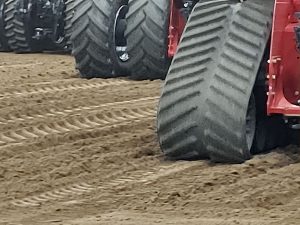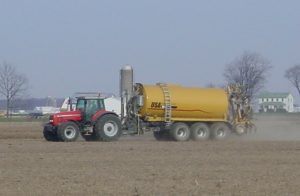Agronomy, Conservation, Homepage Slider
Compaction: Where the rubber meets the road
By Dusty Sonnenberg, CCA, Ohio Field Leader
It can be said that compaction occurs where the rubber meets the road, or in this case, the rubber meets the soil.
“If you think about how roads are designed and built, they are constructed to handle heavy loads. It comes down to a function of the axle weight,” said Ian McDonald, researcher from the Ontario Ministry of Agriculture. “Why do we think it is alright to put heavy axle weight on top of a biological ecosystem?”
In research conducted at Bern University by Matthias Stettler, it suggests that the axel load on equipment in a field should ideally be less than 5 tons per axle and tire inflation pressure should ideally be less than 15 pounds per square inch. Common field equipment axle loads are 7.5 tons per axle for a 200 horsepower 4-wheel-drive tractor, 13 tons per axle for a 325 horsepower 4-wheel-drive tractor, 24 tons per axle for a combine with a 12-row head, and 35 to 40 tons per axle for a 1200-bushel grain cart.
“One of the most important tools a farmer can have as he manages compaction is a tire air pressure gauge,” McDonald said.

And, then it must be used to monitor the proper air pressure for the specifics of the situation.
Typically, there is a recommended inflation for road use that is very different from in-field use.
“If you have to run the roads, for safety reasons, as well as tire wear and load carrying, you need to go with the higher pressure. The problem is that in the field the higher pressure will cause more compaction. If a 40 psi is required for the road, but in the field 10 psi is desired, you cannot average this. It is a lose-lose. While it may seem logical to go with the average inflation pressure, you simply cannot do this,” McDonald said. “New technology is being developed such as automated central inflation/deflation systems that will allow the farmer to adjust the tire pressure for road travel or for in-field use. A system like this could be connected to automatically adjust the tire pressure so it is safe for the road use, but also gives maximum flotation in the field.”
He referenced observing a number of different systems in place to reduce compaction including bigger tires, more tires such as running duals and triples, running lower tire pressure, the use of tire inflation/deflation systems, and even the replacement of tires with tracks. These are all management actions to accomplish the same goal of spreading the footprint of the equipment out across a larger area.
“What matters in soil compaction is the mass of the total load, the pressure that is applied, how that load is distributed over the soil, and what the soil moisture level is,” McDonald said. “The greater the soil moisture level, the greater the potential for compaction to occur.”
In Ohio State University research conducted in a corn crop, a 10-ton axle load showed minimum yield loss under normal soil moisture conditions, however it caused a nearly 10% yield loss in wet conditions. When the axel weight was increased to 20 tons, the results were more dramatic. At 20 tons, under normal soil moisture conditions a 10% yield loss was calculated, and in wet conditions the yield losses increased to as much as 20% from compacted soils.
calculated, and in wet conditions the yield losses increased to as much as 20% from compacted soils.
“Over time as equipment has gotten larger, the load on each wheel has increased. Tires have also gotten larger, however the area of the tire coming in contact with the soil has not increased at the same rate as the equipment weight,” McDonald said. “There is new tire technology for farm equipment. Each company has a chart with specifications regarding the load weight, pressure, speed, and torque recommended that each individual tire can be operated at. Often the equipment owner’s manual will also have specifications that should be followed. It is important to remember that operating outside of these specifications can void the tire warranty.”
The newest tire technology can make a significant difference for individual farms and fields.
“It is important to try to optimize the new tire technology,” McDonald said. “If you do not optimize it, you are losing out in terms of safety, tire wear and potential failure, fuel economy, soil compaction, crop damage, increased input costs, and decreased profits.”
Ohio State University professor and Chair of Food, Agricultural and Biological Engineering Scott Shearer said tire technology is constantly evolving to meet the demands of modern agriculture and help minimize compaction.
“Increased Flexion (IF) and Very High Flexion (VF) tire technology have been developed to address compaction by allowing tires to support heavier loads at lower pressures and with bigger footprints,” Shearer said.
IF tires can carry up to 20% more load at a standard radial’s inflation pressure, or the same load at 20% less psi. VF tires can carry 40% more load at a standard radial tire pressure, or the same load at 40% less psi, Shearer said.
“It is important that the farmer remember that they must adhere to the manufacturer inflation tables when lowering inflation pressures so as not to void the warranty. There is also concern over road stability, which has promoted the development of low sidewall (LSW) tire technology. This would be bigger rims and lower section heights,” Shearer said. “All these tire technologies offer farmers options to help mitigate the high gross vehicle weights.”
And, ultimately for farm fields, technology can help address the compaction challenges where the rubber meets the soil.